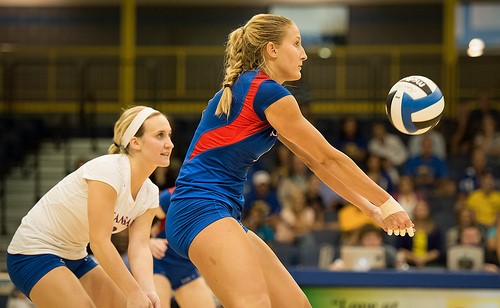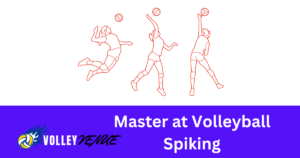Table of Contents
Passing is a crucial element of a volleyball attack, as a player makes a volleyball pass to a setter during a game, enabling the setter to set up an attacker for a strike. Your team’s success in volleyball depends significantly on proper volleyball passing technique. As such, mastering the art of volleyball passes is pivotal for every player striving to elevate their game.
To help you comprehend the essence of volleyball passes and equip you with the knowledge to hone this indispensable skill, this guide delves into the fundamentals of passing in volleyball. You will gain insights into proper positioning, forearm, and overhand passing techniques, as well as drills to enhance your volleyball passing prowess, ultimately boosting your overall gameplay.
Proper Positioning and Stance
The ready position in volleyball is a general positioning of the body that enables you to be physically prepared and in a good position to react to an upcoming play. In a proper volleyball-ready position, your knees should be bent, your hands out in front at waist level and just outside the knees, and your weight balanced forward. Your weight must be balanced forward on the body because this will help you gain momentum. The ready position is extremely important because when properly performed, it can help you react more quickly to an incoming ball.
Feet Placement
It would help if you had your feet spread at about shoulder-length from each other, with one foot slightly in front of the other. Many coaches favor a slight stagger as it is considered a better reaction position than parallel feet. However, which foot to put forward can be left to your comfort. Feet should always be light on the ground and shoulder-width distance apart.
Weight Distribution
Proper weight distribution is crucial for the ready position. Your weight should be evenly distributed on the balls of your feet, not on your heels, as this will slow down your reaction time. With your weight distributed evenly across the balls of your feet, you will be balanced and prepared to use your weight as momentum when the time comes to make a move. Equal weight distribution between the two feet is recommended.
Ready Position
In the ready position, your knees should be bent slightly, but not too much. Your arms should be out and ready for action, with your head up and eyes on the ball at all times. Maintaining a medium body position with shoulders slightly forward and ready to spring laterally, forward or back is crucial. Reminding players of these basic mechanics is critical for a solid foundation, regardless of the team’s level or the athletes’ age.
Forearm Passing Technique
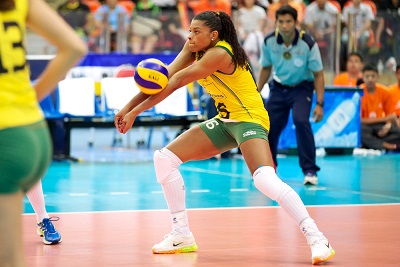
The Palms should face forward with the finger spread in the initial position then bring the hands together in front of the body ideally you should have no gap between your forearms also the forearms should be locked as if locked together tightly during the bump and our shoulders are relaxed ready to react for the incoming ball.
Hand and Arm Placement
After you have moved into position to pass, an early presentation of your platform can insure good forearm contact and an accurate pass. Using good passing posture, your arms are bent and at your sides to assist in movement. Once you have gotten into position you extend your arms and put the heels of your hands together presenting a solid platform for the ball to rebound.
Ball Contact
You want to expose the inside part of your forearms and have the ball contact your forearms from about 1-2 inches to approximately 6 inches above your wrist. Keep your body still and relaxed. This will insure the most ball control and consistency.
Body Movement
The body needs to be leaning forward when playing the bump the idea is to create space between the body and the hands to possibly play the ball not only in for front of the body but also when the ball will fly to the right or the left or when a hard hit is coming at us and we need to absorb its energy and make a back part motion with our hands. For good ball control we have to bend our knees and then lift up when we touch the ball we can play the bump on Outreach legs with our butts out this lifting is not just lifting up but also forward the hands should always be pointing forward at about a 45-degree angle because we almost always play the ball forward on the bump for a distance of five or more meters.
Overhand Passing Technique
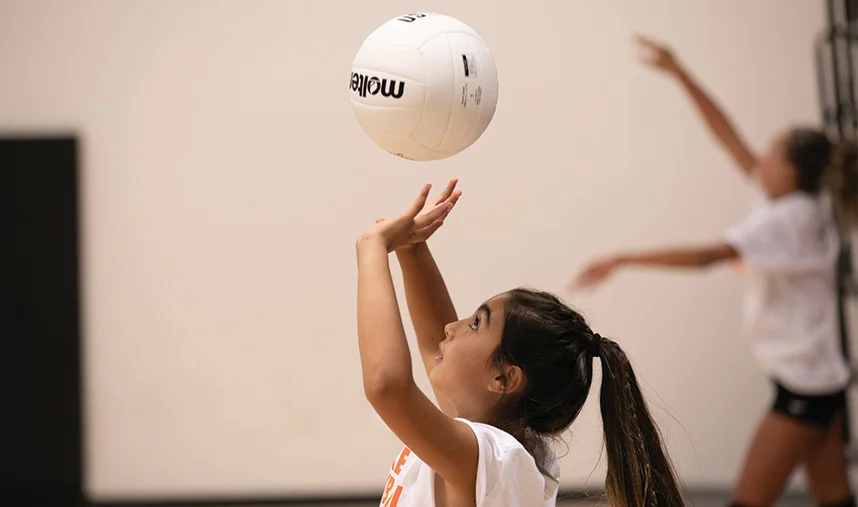
The overhand pass, including the overhead pass, is another essential skill in volleyball. This technique is often used when the ball is coming from a higher trajectory, making the forearm pass impractical. In an overhand pass, players use their hands to contact the ball above their heads. The volleyball overhand pass requires good hand-eye coordination and timing. Players must judge the ball’s speed and trajectory, positioning their hands correctly to guide the ball to its intended destination.
Hand Positioning
To execute a proper overhand pass, start by positioning your hands and forearms correctly. Extend your arms in front of you, keeping them straight but relaxed. Ensure your fingers are not interlocked, rather, one of your hands is making a fist, with the other wrapping around it with your thumbs touching. Bring your wrists together, forming a flat surface with your forearms. This is where the ball will make contact during the overhand pass.
Ball Trajectory Anticipation
An exceptional passer not only reacts to the ball but anticipates its trajectory. By studying the server’s body language, arm swing, and contact point, you can predict the direction and speed of the incoming serve. Anticipation allows you to position yourself optimally and move proactively, gaining an advantage in making successful passes and controlling the game tempo.
Timing and Control
Timing is essential when it comes to overhand passing. Anticipate the ball’s trajectory and make contact at the right moment. As the ball reaches you, bend your knees and use a slight upward motion to meet the ball’s descent. Aim to make contact with the ball on your forearms, just above your wrists. Ensure a clean and controlled contact to accurately direct the ball. When executing an overhand pass, it’s important to absorb the force of the ball’s impact. As you make contact, allow your arms and wrists to flex slightly, absorbing the energy of the ball. This helps to reduce the rebound and maintain control over the pass.
Practice and Drills
Passing Drills
To solidify your passing technique, engage in drills that provide ample repetitions and touch opportunities. A time-efficient drill shared by Coach Cary Wendell Wallin, a former U.S. national team member and NCAA Player of the Year at Stanford, emphasizes forming a solid passing platform, fundamental footwork, and handling off-target serves.
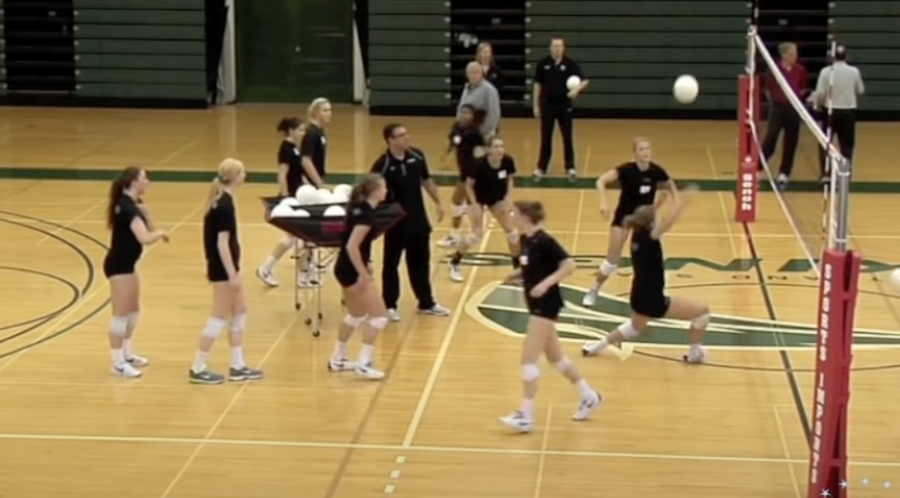
In this drill, partners take turns tossing underhand tosses to each other from the net. The passer moves their feet, creates a platform, and contacts the ball with forearms together, targeting the tosser. After 10 reps, switch roles. Progress by having the tosser toss both short and deep balls, requiring the passer to react quickly and adjust their platform accordingly.
For short serves, drop your lower body closer to the floor and raise your platform. For deep serves, take shuffle steps backward, hunch your shoulders, and use a lower platform angle. If unable to get back far enough, pivot your body and create a side platform.
Partner Drills
Incorporate partner drills that simulate game situations, such as passing, setting, and hitting sequences. As former national team coach Marv Dunphy suggests, skills are best learned within the game context rather than as isolated entities.
Two players can take turns tossing balls to a passer between them. After passing to the first tosser, the passer rotates 180° to receive and return the ball to the second tosser, mimicking game-like movement and positioning.
Game Simulations
Develop game-like, competitive drills by manipulating variables like court dimensions, scoring systems, player numbers, or specific rules of play. These drills force players to think, stay mentally engaged, execute game plans, compete, and find ways to win while developing skills in a game context.
Examples include playing on smaller or larger court areas, scoring bonus points for specific skills, starting at designated scores, limiting contacts or player roles, or initiating play from specific situations like free balls or joust scenarios. Such simulations help players transition smoothly from drills to actual gameplay.
Conclusion
Mastering the art of volleyball passes is an essential skill that can significantly elevate your game and contribute to your team’s success. By understanding the fundamentals of proper positioning, forearm and overhand passing techniques, and engaging in targeted drills and practice routines, you can hone your passing prowess and become a more well-rounded player. Remember, consistent practice and a commitment to perfecting these skills are key to unlocking your full potential on the court.
Ultimately, passing is the foundation upon which offensive strategies are built, and every player should strive to develop this crucial aspect of their game. By implementing the insights and techniques shared in this guide, you’ll not only enhance your individual performance but also contribute to the cohesiveness and effectiveness of your team’s overall gameplay. Embrace the journey of continuous improvement, and watch as your volleyball skills soar to new heights

